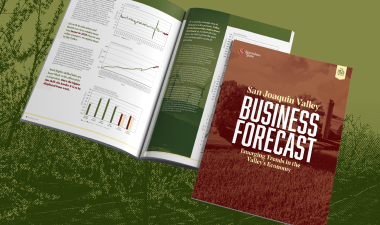With a continued slowdown in the national economy and the San Joaquin Valley that began in early 2022, the Federal Reserve has announced three rate cuts for 2024.
Experts caution that without intervention, the labor market’s downturn — evident from unprecedented declines in employment during the normally robust months of July and August — could reach a critical crossroads. Rate cuts in 2024 will likely avert a more serious contraction that would last into 2025.
To safeguard against economic uncertainties, Valley residents should consider the following measures:
- Maintain a larger cash reserve,
- Delay buying a home and opt to rent,
- Shift from fixed to flexible interest rate options,
- Invest in bonds, and
- Consider leveraging student loans to acquire new skills in the event of job layoffs.
These recommendations form part of the outlook for the upcoming year as detailed in the biannual San Joaquin Valley Business Forecast, produced by Gökçe Soydemir, the Foster Farms endowed professor of business economics at Stanislaus State.
Among the highlights:
Employment Indicators
All employment categories, except for construction and retail and wholesale trade, experienced growth in 2023. However, projections suggest that employment levels will drop in 2024, with a potential rebound in 2025 with the announced rate cuts in 2024.
Housing Sector
After registering 12.30 percent growth in 2022, Valley building permits declined by 9.62 percent in 2023, reflecting a slowdown in the housing sector. As workers mostly held on to their jobs in 2023, the region avoided foreclosures. Valley home values saw a modest increase of 1.88 percent in 2023, and they are likely on the path to experiencing a decline for the first time since the Great Recession. Because there is a significant inventory shortage, any market correction is expected to be short lived.
Inflation and Prices
Wage inflation, coupled with high gas prices, is seen as the main culprit of persistent inflation in 2023. Average weekly wages increased by 6.01 percent in 2023, surpassing the overall price growth of 4.71 percent, resulting in a real wage increase and a purchasing power gain of 2.79 percent in the Valley. However, projections indicate a trend toward lower wage growth rates and deflation in the next two years with potential declines in Valley consumers’ purchasing power.
Banking and Capital Markets
In 2023, total deposit growth at Valley community banks declined dramatically, dropping from 10.10 percent in 2022 to just 0.92 percent. This substantial decline in deposit growth is partly attributed to bank closures and mergers with banks outside the region. In contrast, net loans and leases experienced a rise of 9.54 percent in 2023, which was faster than the 4.90 percent increase in 2022. Such an imbalance between deposit growth and net loans and leases, like the scenario observed in 2008, raises concerns for sustained long-term growth.
About the Report and Author
Gökçe Soydemir’s biannual Business Forecast provides projections for the Valley’s labor market, regional housing conditions, prices and inflation, banks and other depositary institutions and capital markets. Soydemir and his team use a unique forecasting model that produces lower and upper statistical confidence bands with results that are expected to fall within this range.
Soydemir joined Stanislaus State as the Foster Farms endowed professor of business economics in 2011. He brings strong expertise and experience in business analysis and forecasting and has published extensively on applied econometrics, regional economics, financial forecasting, market analysis and international finance.



